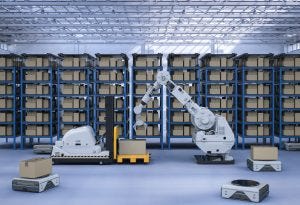What the Future Holds for Warehouse Automation
Experts offer their opinions on warehouse automation trends, and what’s in store for 2023

Robotics and automation solutions have gained in popularity and deployment over the past year, as businesses rally from the supply chain disruptions and labor shortages exacerbated at the height of the pandemic’s restrictions. Business models are changing, and the warehouses and factories behind them are similarly shifting to embrace a more flexible, automation-centric approach. IoT World spoke to robotics and automation solution providers about this shifting landscape, what they’re doing to meet consumer demand, and what the future holds for warehouse automation.
What’s in Store for 2023?
 A.K. Schultz, CEO of SVT Robotics: “One of the biggest changes that I’ve seen is the strategic outlook of CEOs, saying that while optimization is great, flexibility is more important,” said Schultz. “If you think about the supply chain as a guitar string, over years supply chain professionals have increased the tension on that guitar string. Inventory was very very optimized and it didn’t take much to snap that string – COVID allowed us to glimpse that before it was due.
A.K. Schultz, CEO of SVT Robotics: “One of the biggest changes that I’ve seen is the strategic outlook of CEOs, saying that while optimization is great, flexibility is more important,” said Schultz. “If you think about the supply chain as a guitar string, over years supply chain professionals have increased the tension on that guitar string. Inventory was very very optimized and it didn’t take much to snap that string – COVID allowed us to glimpse that before it was due.
“Now the focus is on flexibility across a supply chain; commercial flexibility, digital flexibility and physical flexibility.”
Schultz says the world is biased toward mobile robots, equipment that does not require major building changes and the concept of robots-as-a-service, yet, “the fastest growing robotics and automation companies are mobile robotics, modular robotics, every single day it is gaining momentum. All this provides intense commercial and physical flexibility.”
“Digital flexibility is a bit harder to achieve, because we have to customize and connect these monoliths of legacy software, which is very hard to change. The best way to cure that is to start building things the right way, though this requires more effort up front.”
Vince Martinelli, head of marketing at RightHand Robotics: “There is universal agreement that warehouse automation, and specifically, robotics, is an ‘inevitable’ wave that is necessary due to the mix of steadily increasing e-commerce demand and quickly shrinking labor pools for entry-level, highly repetitive, ‘dull’ jobs,” said Martinelli. “The pandemic exposed how unprepared the world of retail and all supply chains, in general, are for keeping goods flowing smoothly, given these trends.”
“But there is still a tale of two adoption curves that are happening in parallel. Companies that are well-capitalized and whose businesses have weathered the pandemic and current economic headwinds are investing in automation and have very ambitious plans. Other companies who are less financially secure, still have long-term plans for increasing their automation investments, but have had to place those strategies on the back burner in the near term to preserve cash.”
Björn Bartheidel, Syntax vice president of intelligent industry services: “We are particularly focusing on smart factory technologies and implementation of solutions in the area of Industry 4.0 and Digital Manufacturing for our customers,” Bartheidel said. “A key trend is that new customers are focusing on using public cloud solutions to digitize their shopfloor processes instead of legacy “Manufacturing Execution On-Premise Solutions”.”
“We have great examples where we implemented SAP Digital Manufacturing Cloud to increase staff productivity (e.g. by better worker guidance and optimized planning processes) or improve product quality by leveraging in-process visual inspection features using AI technologies.”
Alex West, Omdia senior analyst, industrial IoT and sustainability: “One of the big trends set to emerge in 2023 is that companies are going to continue to use sustainability as a vehicle to drive their digital transformation programs,” West said. “While previously equipment and automation vendors introducing digital transformation found it hard to justify the immediate cost of optimizing processes, now with sustainability it’s a must.”
“Data is going to be a continued key trend in 2023, but it’s going to have much more of a green data angle. We’re going to see a lot more carbon dioxide trackers, environmental footprint trackers coming into the market to help companies pivot to sustainability.”
“Software-defined automation is also going to be a big trend for 2023. You’re seeing a lot of industrial automation equipment becoming more intelligent, and this intelligence is being distributed further down to the edge devices. Hardware is becoming less proprietary, more open, and increasingly we’re seeing a shift to software, and a move to really converge OT and IT on the factory floor.”
“The industrial metaverse is also going to be a topic that’s talked about a lot. The idea is still fairly new, so companies are still working out exactly what that will look like, but certainly, there’ll be a lot more focus on that next year.”
What Challenges Remain in Warehouse Automation?

Schultz: “The biggest bottleneck into deployment of robotics is the overworked IT professionals that we have in this industry. It’s created this mountain of what we call ‘technical debt,’ which means that by doing things without being modular, you have essentially made it harder for yourselves later and every day that goes by, as it makes it even harder to unwind.”
“Within the next few years, demand for robotics will double. If we look at the old way of doing things, there are about 15,000 people in the U.S. with the skillset to create the systems behind the devices, and to meet the rising demand we’ll need maybe 15,000 additional people who can do it. There is no training solution that will solve this problem. There is one way to solve this problem, and that’s to make it easier to do the work.”
“This creates an entirely new accessibility of people being able to participate in a robotics revolution rather than being sidelined by it. By providing a toolset that does not require a computer science degree, then suddenly, there’s a lot of people who can create really strong careers in an industry that may otherwise have passed them by.”
Martinelli: “Having been through similar product adoption cycles in prior firms, my opinion is that it generally comes down to building up the library of proof points, which in the case of robotics means successful implementations where the end customer operating the warehouse sees tangible benefits, whether the system is sold by us or through one of our system integrator partners like Element Logic or Vanderlande, for example.”
“From our perspective, it’s more about execution and productization at this stage as opposed to hoping for some new breakthrough.”
“It’s a golden age for robotic warehouse automation and systems built on vision-based AI. There is intense optimism about how this new generation of products will revolutionize how goods move from manufacturers to retailers and to customers, promising even more product assortment that can be quickly delivered anywhere to meet consumer demand.”
Bartheidel: “It’s clearly not an issue of missing technology. What’s important is the understanding of factory needs and combining this with the knowledge on how to leverage those new technologies and solutions.”
“We are using more and more Process automation approaches and technologies to automate simple and repetitive tasks and to provide a better user experience. The pace of technological innovations and the availability of new services is so fast that our customers often do not have the skills or the capacity to keep track of this. New Cloud solutions are provided every 3 months with new features that are automatically deployed and also tested. This requires new ways for implementing those solutions, but also operating those solutions after Go-Live.”
“With the future of warehousing, there is definitely room for more process automation, which we see as the emerging technology in the space – or AIoT more specifically. But a large part of optimizing your technical staff is to leverage AI to reduce manual intervention and free up staff to focus on other high-value tasks while AI handles the more repetitive tasks.
“This is critical when you have a warehouse that can stretch for blocks. But AIoT allows you to cover more ground. Automated forklifts can carry heavy items from point A to B. Sensors can detect when specific items have spoiled or have broken in transit. Floor managers can wield hand-held IoT sensors to capture barcode data and send it to a centralized inventory system managed by AI – this creates more accurate data inventorying.”
West: “You’ve got the macroeconomic challenges. A lot of companies have been hit by all the challenges going on from the pandemic to the global political tensions. That’s hindering businesses in terms of investment, with companies less likely to take the plunge in terms of making large-scale investments.
“Another challenge is the nature of manufacturing itself. A lot of these systems are 20 to 30 years old, and it’s not the kind of system that gets an update every few years. The ability to future-proof this equipment and make it IoT-enabled is not something you can just turn on. Manufacturing is a really slow-moving industry, and with the presence of this legacy equipment, digital transformation is still going to take some time.”
About the Author
You May Also Like








